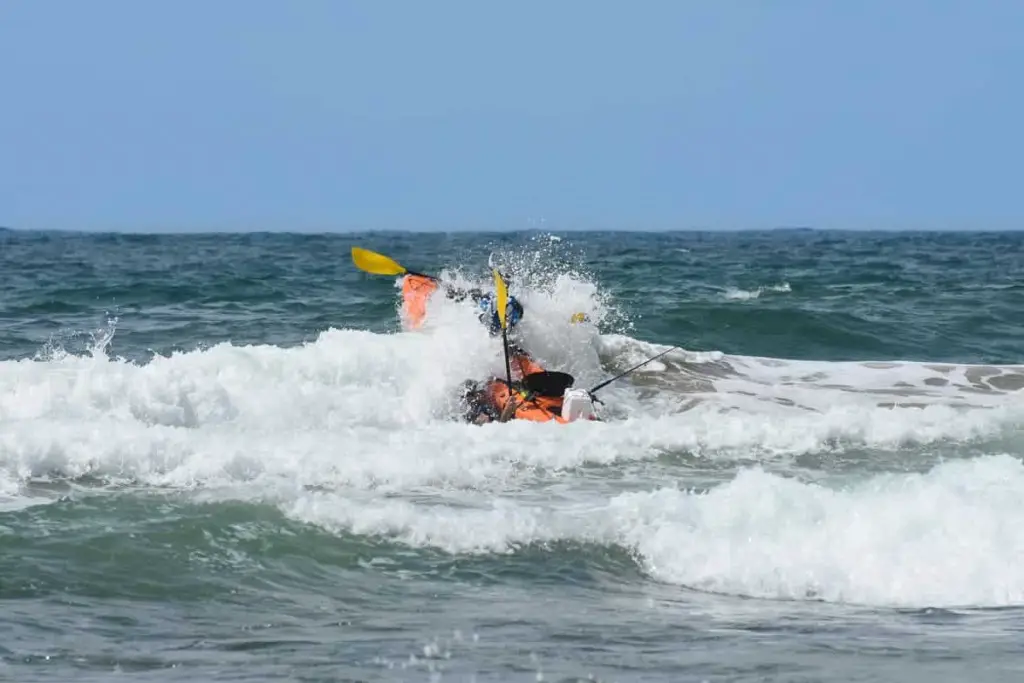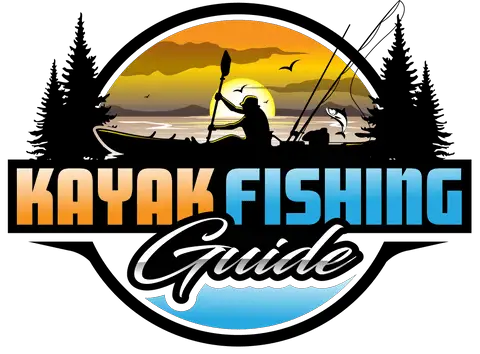This post contains affiliate links.

Ocean fishing in a kayak is a lot different than fishing in a lake or river. You can’t always guess if the water will be calm or rough because it depends heavily on the weather and tides.
The kayak size for ocean fishing is a minimum of 12 feet because it’s small enough to maneuver but large enough not to swamp quickly, a 14-foot kayak is preferable. The dimensions, weight, and the type of seating the kayak provides will determine if a kayak is right to use for ocean fishing.
Not every 12-foot kayak is made the same, so let’s take a look at what makes a kayak suitable for ocean fishing.
An Overview of Kayaks
A kayak is a single person or two-person (tandem) watercraft and used for sports or recreation. To propel it across the water, you generally have to use a paddle. You will find newer models with pedals and electric motors, however.
Kayaks are long and narrow. Some of them are made for speed and lack stability, while others are made to be stable and lack speed. Shorter kayaks are easier to turn, but they won’t track and move as fast as a longer kayak.
On the other hand, longer kayaks will be able to move quickly, but you’ll have a hard time maneuvering them in small spaces. Larger kayaks are more suitable in open bodies of water.
A tandem kayak can be used by one person, but it will be more challenging to maneuver. But, if two people are in a kayak, you can propel quickly across the water.
If you want a kayak that’s perfect for ocean fishing, you need to consider the following:
- Dimensions
- Sit-in kayak (SIK) or sit-on-top (SOT)
- Keel
- Weight
- Single or tandem
A 12-foot kayak is generally the minimum length recommended for ocean fishing. Still, you need to have a clear understanding of how each of these aspects of the kayak will affect your fishing experience in the ocean.
Dimensions
The basics are always the most critical part, and that also holds for kayaks. The length, width, and height will determine how it functions on the water.
Length
The longer the kayak, the faster it will go. If you want to travel long distances in your kayak, then you’ll probably want one that exceeds 12 feet. Remember that the longer the kayak, the harder it is to get it turned around.
Think about how you’re going to fish. You probably won’t have to travel too far into the ocean to start fishing so that speed won’t be your biggest concern. Instead, you’ll need something stable that will allow you to sit and fish in possibly choppy waters. Since the ocean is wide open, you won’t have to turn around too much. So, a longer kayak won’t be much of an issue for you.
Kayaks that are shorter than 12 feet have the potential to become unsafe in rough water. Plus, you’ll have less storage for your gear, and they tend to have lower weight limits.
For more information on the weight limits of kayaks and how weight limits affect the kayak, you’ll want to check out my other article: Kayak Weight Limits Explained for Larger Anglers
Width
Wider kayaks are typically more stable than the narrow ones. When you have to bring additional fishing gear and equipment with you, a wider kayak is better suited. You will have plenty of room to store your gear, and it will be able to handle the weight of everything you bring with you.
After a full day of catching and landing fish, a wider and more stable kayak will also allow you to bring along an extra-large fish bag or cooler! So you can bring that great catch back home with you for the table!
- Want to know more about carrying coolers on your kayak? Check out my article: How Do You Carry a Cooler on a Fishing Kayak?
Height/Depth
The height of the kayak, which is also the depth of it, affects the following:
- Response to the wind – Deeper kayaks are more prone to being knocked over by the wind, while shallow kayaks won’t be affected.
- Storage space – Shallow kayaks won’t be able to store many things. If you need a lot of room, it’s in your best interest to get a deep kayak.
- Size and comfort of the user – If you’re a larger or tall person, you’ll likely be more comfortable in a deep sit-in kayak (SIK). You have to position your feet to brace yourself. If you’re not comfortable or can’t correctly position your legs, you risk negatively affecting your posture.
SIK or SOT Kayaks
SIK, or sit-in kayaks, are the kind that has a sunken-in seat, so you’re sitting inside the kayak, and your legs are covered. SOT, or sit-on-top, kayaks have a seat carved out on top. Your legs are exposed, and the kayak isn’t very deep.
SOT kayaks are typically better for ocean fishing. You’ll get wet more, but they can’t fill with water (they have ‘scupper holes’ which allow the water to drain back out). Sit-on-tops are safer, and they will enable you to move around as needed.
Sit-in -kayaks will keep you drier than a sit-on-top kayak will, but you won’t be able to move around as much. But, a sit-in-kayak might be preferable if the water is moving and your kayak is lightweight.
SOT kayaks will allow you to carry more fishing gear and equipment since they have more storage area. Plus, you can move around more freely! The extra room by sitting on top is a tremendous advantage to have when you want to fish and move around.
Keels
A keel is a plastic piece that sticks out from the kayak. It helps your kayak with speed and tracking. Tracking helps your kayak go straight.
Kayaks with keels are typically V-shaped and offer more stability when the water is still. For ocean fishing, you’ll probably want a keeled kayak.
Kayaks that don’t have keels are U-shaped and help the kayak remain stable in moving water. This sounds like a smart option for the ocean, but a kayak that doesn’t have a keel is more likely to spin in circles, and that won’t make fishing easy.
Some SOT kayaks are slightly W-shaped with two shoulders and a keel in the middle. These are great for ocean fishing because they offer plenty of stability. But you won’t be able to go very fast because this tri-form kayak isn’t very fast.
Weight in and Out of the Water
Consider the weight of the kayak on land and in the water. Consider how heavy it is when you buy it and how heavy it will be once it contains 1-2 people, fishing equipment, and the fish you caught. Can it support all the weight? Can your car support the weight of the kayak so you can transport it to the fishing site?
Single or Tandem Kayaks
The last thing to consider is whether you want a single person or a tandem kayak. Consider the factors mentioned above, such as how length and width affect how the kayak functions. Two people might be more comfortable in a larger kayak, but large sizes can be challenging to handle even in open water.
Conclusion: The Best Kayak Size for Ocean Fishing
A 12-foot kayak is a minimum length recommended for ocean fishing. This size of kayak is easy to maneuver and doesn’t lack much speed. It’s better to have a sit-on-top (SOT) kayak because it can’t fill with water if it tips over. It’s also easier to fish on since you can drop a leg off each side if necessary while reeling in a fish.
You need to be sure that the kayak will be able to carry the weight of the 1-2 people that will be in it and the supplies you need to take with you. Your vehicle also needs to be able to carry it to the fishing site, so it needs to be a suitable weight to carry on your vehicle.
Related Article: How to Outfit a Kayak for Fishing: The Ultimate Guide
Thanks for stopping in and stay safe out there!
